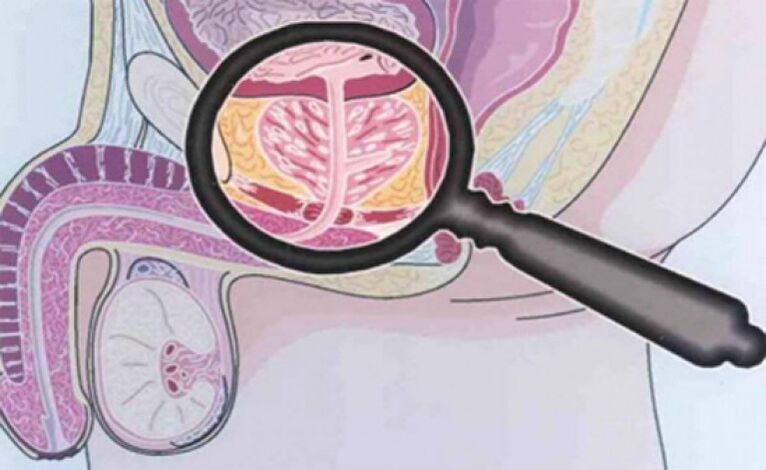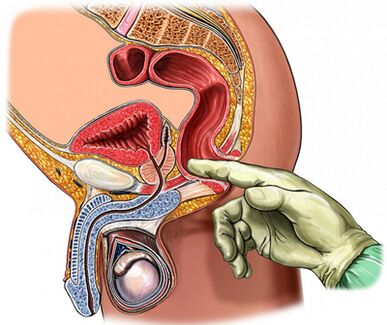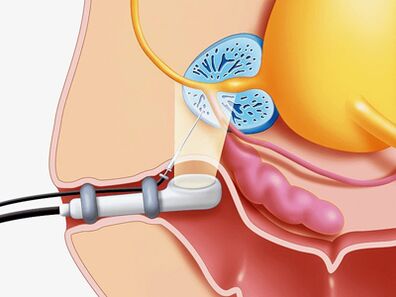According to many experts, chronic prostatitis is an infectious inflammatory disease that can be accompanied by autoimmune disorders, characterized by damage to the parenchyma and interstitial tissues of the organ. The disease has been known to medicine since 1850, but even today it is poorly understood and responds poorly to treatment. Chronic bacterial (6-10%) and non-bacterial (80-90%) chronic prostatitis are the most common and social inflammatory diseases in men, significantly reducing the quality of life of men. surname. The disease is noted mainly in young and middle-aged people and is often complicated by impaired reproductive and sexual function (decreased potency, infertility, etc. ). The disease is reported in men with 8-35% of cases between the ages of 20 and 40.
Bacterial prostatitis is caused by pyogenic bacteria, which enter the gland from the urethra, or via the lymphatic and hematopoietic routes. The etiology of chronic nonbacterial prostatitis and its pathogenesis are unknown. It affects mainly men over the age of 50.

The reasons for the development of the disease
Chronic prostatitis is now considered a disease of a polarizing nature. It is suggested that the disease arises as a result of the penetration of the infection into the prostate gland, and then the pathological process takes place without its participation. Several non-infectious factors contribute to this.
Infectious factors in the development of chronic prostatitis
In 90% of cases, the pathogen enters the gland from the urethra, leading to acute or chronic prostatitis. There have been cases of asymptomatic transport. The course of the disease is influenced by the self-defense state of the human body and the biological characteristics of the pathogen. It is thought that the transition from acute prostatitis to chronic prostatitis occurs due to loss of tissue elasticity due to overproduction of fibrous tissue.
Among the causative agents of chronic prostatitis, the following pathogens are found:
- In 90% of cases, the disease detects gram-negative bacteria such as Escherichia coli (E. coli), Enterococcus faecalis (intestinal bacteria), less often - Pseudomonas aeruginosa, Klebsiella spp. , Proteus spp. , Pseudomonas aeruginogenes and Enterobacter . Gram-positive enterococci, streptococci and staphylococci are very rare.
- The role of coagulase-negative staphylococci, ureaplasma, chlamydia, Trichomonas, gardnerella, anaerobes and fungi of the genus Candida has not been fully elucidated.
Infections enter the prostate in a number of ways:
- An ascent pathway is most likely, as evidenced by the frequent combination of prostatitis and urethritis.
- Endogenous prostatitis develops when the infection enters the gland with the bloodstream, is observed in chronic tonsillitis, sinusitis, periodontitis, pneumonia, cholecystitis and cholangitis, diseases withpus in the skin, etc. v.
- On contact, chronic prostatitis develops with urethritis and urethral stricture, as infection enters the gland ascending with urine stream, with purulent infection of the kidney, following the medullary canal for inflammation. epithelium, salpingitis and salpingitis, in urological diagnostic and therapeutic manipulations (catheterization, urethritis), including transurethral.
- Lymphatic infection infiltrates the prostate with prostatitis, thrombophlebitis, etc. v.

Non-infectious factors in the development of chronic prostatitis
Chemical element
According to experts, a leading role in the development of chronic prostatitis belongs to the internal regurgitation of urine, when urine is ejected from the urethra into the gland, leading to impaired emptying of the bladderprostate and seminal vesicles.
With this disease, vascular responses develop, leading to organ edema, neurologic and humoral regulation of the tone of the smooth muscle tissues of the urethra is disturbed, alpha activation.one–Adrenergic receptors induce the development of dynamic occlusion and contribute to the development of new intravenous reflux.
Urates contained in the urine, with reflux, lead to the development of a "chemical inflammatory response".
Hemodynamic disorders
They aid in chronic inflammation and circulatory disorders in the pelvic organs and scrotum. Congestion develops in people with sedentary lifestyles, e. g. drivers, office workers, etc. v. , suffering from obesity, hypogonadism, sexual dysfunction, frequent hypothermia, mental and physical overload. The consumption of spicy and spicy foods, alcohol and smoking, etc. , contribute to the maintenance of the inflammatory process.
Other factors
There are many other factors that support chronic prostatitis. Including:
- Hormonal.
- Biochemistry.
- Decreased immune response.
- Autoimmune mechanism.
- Infectious and allergic processes.
- Features of the glandular structure of the prostate gland, leading to difficulty in adequate drainage.
Very often, it is not possible to determine the reason for the development of chronic prostatitis.
Classification of prostatitis
According to the classification proposed in 1995 by the US National Institutes of Health, prostatitis is divided into:
- Acute (class I). It's 5 - 10%.
- Chronic bacteria (type II). It's 6 - 10%.
- Chronic non-bacterial inflammation (type IIIA). It's 80-90%.
- Chronic pelvic pain syndrome is not caused by bacteria (type IIIB) or chronic.
- Chronic prostatitis, incidentally diagnosed (type IV).
Signs and symptoms of chronic prostatitis
The course of chronic prostatitis is long, but not monotonous. Episodes of exacerbation are replaced by periods of relative calm, which occur after complex anti-inflammatory and antibacterial therapy.
The development of chronic bacterial prostatitis usually precedes urethritis of a bacterial or gonorrhoeic nature, non-bacterial circulatory disorders of the pelvic organs and scrotum (hemorrhoids, varicose veins). spermatic vessels, etc. ), sexual excess.
Patients with chronic prostatitis have many complaints. They go to the doctor for many years, but rarely get a prostate exam. About a quarter of patients do not have any complaints, or the disease progresses with minimal clinical symptoms.
Complaints of patients with chronic prostatitis can be divided into several groups.
Urinary disorders associated with urethral stricture:
- Difficulty starting to urinate.
- Weak urine stream.
- Intermittent or dropwise urination.
- Feeling of incompleteness of the bladder.
Symptoms due to irritation of nerve endings:
- Urinate frequently.
- The need to urinate is sharp and violent.
- Urinating in small portions.
- Inability to control urine when you want to urinate.
Pain syndrome:
- The intensity and nature of the pain is different.
- Location of pain: lower abdomen, perineum, rectum, groin and lower back, inside thighs.
Sexual dysfunction:
- Pain in the rectum and urethra during ejaculation.
- Sluggish erection.
- Loss of orgasm.
- Premature ejaculation, etc. v.
As for the nervous system: a nervous disorder in the form of fixing the patient's attention on their state of health.
Signs and symptoms of chronic nonbacterial prostatitis
Chronic pelvic pain syndrome in men (CPPS) occurs with the usual symptoms of chronic prostatitis, but bacteria are absent in the 3rd part of urine and in prostate secretions. CPPS can be simulated by chronic nonbacterial interstitial cystitis, rectal diseases, spastic pelvic floor muscle pain syndrome, and impaired prostate function due to internal organ dysfunction. and its hemodynamics.
If neuromotor function is impaired, loss of tone and violation of glandular encapsulation are noted, manifested by difficulty in rapid and complete closure of the urethral lumen. At the same time, urine after urination continues to be excreted for a long time drop by drop. In such patients, research shows instability and increased excitability, manifested by increased sweating and stimulation of cardiac activity, changes in cerebral blood vessels.

Complications of the disease
The long-term course of chronic prostatitis is complicated by a decline in sexual and reproductive function, the development of such diseases as vesicular and gonadal inflammation, as well as organ stiffness. Organ sclerosis exacerbates local microcirculation and urodynamics, as well as the outcome of surgical interventions. The fibrosis of the tissues around the mouth leads to the development of urinary disorders.
Diagnose
The fact is that there are many reasons that lead to the development of chronic prostatitis, so there is a wide range of diagnostic studies used to diagnose it. The success of treatment depends on the correct identification of the underlying cause. Diagnosis of chronic prostatitis is based on the following data:
- The classic triad of symptoms.
- A set of physical methods (digital rectal examination of the prostate).
- A set of laboratory methods (urine analysis and prostatic secretion microscopy, culture and susceptibility determination of the microbiome to antibacterial drugs, general analysis of urine and blood).
- For the detection of gonococci, microscopic examination of a urethral smear, PCR and serological methods (for the detection of ureaplasmas and chlamydia).
- Measurement of the urethra.
- Prostate biopsy.
- Complex of instrumental methods (ultrasound).
- Determine the patient's immune status.
- Determine neurological status.
- If treatment is ineffective and complications are suspected, computed tomography and magnetic resonance imaging, blood cultures, etc. v.
Prostate palpation
Of paramount importance in the diagnosis of the disease is palpation of the prostate, the prostate is increased during the exacerbation phase and decreased during the ablation phase of the inflammatory process. In chronic prostatitis during iron exacerbation, it is edematous and painful.
Organ density may vary: soft and compressed areas are palpable, concave areas are identified. Palpation can assess the shape of the gland, the condition of the testicles and surrounding tissues.
Digital rectal examination combined with collection of glandular secretions. Sometimes it becomes necessary to get the secret from each separate share.

Analysis of 3-glass urine samples and prostate secretions
The "gold standard" in the diagnosis of chronic prostatitis is:
- Collect the first urine.
- Collect the second part of the urine.
- Get the secretions of the gland by massaging.
- Collect the third part of the urine.
Furthermore, a microscopic and bacteriological examination of the material is performed.
With prostatitis:
- Microbial count (CFU) exceeding 103/ml (10 . )four/ml for epidermal staphylococci), but do not ignore the small number of bacteria in the tens and hundreds.
- The presence of 10-15 leukocytes in the field of view, detected microscopically, is the generally accepted criterion for the presence of an inflammatory process.
Secrets of the prostate gland and the 3rd part of urine are examined with a microscope and bacteria:
- In chronic bacterial prostatitis, there is an increase in the number of leukocytes in the excretory glands, and in the third part of the urine after massaging, bacteria (mainly of the intestinal group) are excreted.
- With nonbacterial prostatitis, there is an increase in the number of leukocytes in the secretory glands, but the microflora is not detected.
- With CPPS, there is no increase in white blood cell count and microflora.
The normal secretion rate of the prostate gland:
- Less than 10 white blood cells in the field of view.
- There are a lot of lecithin granules.
- The microbiome is absent.
In chronic prostatitis, the secretion of the prostate gland reveals:
- Large white blood cell count - more than 10-15 in the field of view.
- The amount of granular lecithin is reduced.
- The pH of the secretion shifts to the alkaline side.
- The amount of acid phosphatase is reduced.
- Lysozyme activity is increased.
Obtaining a negative result for prostatic secretions does not demonstrate the absence of an inflammatory process.
The value of the prostate secretion crystallization test is retained. Usually, during crystallization, a characteristic pattern is formed in the form of a fern leaf. In case of violation of the synthetic properties of the secreting prostate, such a pattern will not form, which happens when the androgenic background changes.

Ultrasound procedure
If prostate disease is suspected, an ultrasound examination of the prostate is used (transrectal ultrasound is optimal), the kidneys, and the bladder, to be able to identify:
- The volume and size of the gland.
- The presence of calculus.
- The size of the seminal vesicles.
- Condition of the walls of the bladder.
- The amount of urine left over.
- Scrotal structures.
- Another kind of disease.
Other methods of prostate examination
- The state of urodynamics (a study of the flow rate of urine) is easily and simply determined using a study such as flow cytometry. With the help of this study, it is possible to promptly detect signs of bladder outlet obstruction and perform dynamic observation.
- A puncture biopsy is performed if abscess formation, benign hyperplasia, and prostate cancer are suspected.
- To clarify the reasons for the development of infrastructural obstruction, X-ray and endoscopic studies are performed.
- With a protracted inflammatory process, urethroscopy should be performed.

Differential diagnosis
Chronic prostatitis should be differentiated from varicocele, autonomic prostatitis, congestive prostatitis, pelvic floor muscle pain, neuropsychiatric disorders, hypertrophy, reflex sympathetic dystrophyradiation, inflammatory diseases of other organs: interstitial cystitis, vesicular osteoarthritis, cervical hyperthyroidism, prostate and bladder cancer, urolithiasis, chronic epididymitis, inguinal hernia.
Treatment of chronic prostatitis
Treatment of chronic prostatitis should begin with lifestyle and dietary changes.
In the treatment of disease, drugs are used simultaneously acting on different pathogenesis links.
The main directions of treatment:
- Eliminate pathogenic microorganisms.
- Anti-inflammatory therapy.
- Normalizes blood circulation in the prostate and pelvic organs.
- Normalizes adequate drainage of prostatic acini.
- Normalizes the hormonal profile.
- Prevention of organ sclerosis.
For the treatment of chronic prostatitis, drugs of the following groups are used:
- Antimicrobial.
- Anticholinergic.
- Vasodilators.
- Alphaone- Adrenergic blocking drugs.
- 5 alpha reductase inhibitors.
- Cytokine inhibitors.
- Non-steroidal anti-inflammatory.
- Vasoprotective drugs.
- Immunosuppressive drugs.
- Drugs affecting urate metabolism.
Antibiotics in the treatment of chronic bacterial prostatitis
Antibiotic therapy should be carried out taking into account the susceptibility of the identified microorganisms to the antibiotic. If the pathogen is not identified, empiric antibiotic therapy is used.
The drugs of choice are second- and fourth-generation fluoroquinolones. They quickly penetrate into the tissues of the gland using the usual methods of application, are active against a large group of gram-negative microorganisms, as well as ureaplasma and chlamydia. In cases of unsuccessful antibiotic treatment, one should assume that:
- multidrug resistance of the microbiota,
- short courses of treatment (less than 4 weeks),
- wrong choice of antibiotic and its dosage,
- change in pathogen type,
- presence of bacteria living in the ducts of the prostate gland, covered by a protective extracellular membrane.
The duration of treatment should be at least 4 weeks with subsequent bacteriological control mandatory. If there are more than 10 bacteriuria in the 3rd part of urinary excretion and prostate3CFU/ml, a repeat course of antibiotic treatment is prescribed at intervals of 2 to 4 weeks.
Cytokine inhibitors in the treatment of chronic prostatitis
Cytokines are glycoproteins secreted by immune cells and other cells in response to inflammatory and immune responses. They take an active part in the development of the chronic inflammatory process.
Non-steroidal anti-inflammatory drugs
Non-steroidal anti-inflammatory drugs have anti-inflammatory, analgesic and antipyretic effects. They are widely used in the treatment of chronic prostatitis in the form of tablets and suppositories. The most effective route is rectally.
Immunotherapy
In the treatment of chronic bacterial prostatitis, in addition to antibiotics and anti-inflammatory drugs, immunomodulatory agents are used. The most effective is the rectal line of their administration. Widely used immunomodulators, which increase the functional activity of phagocytic cells, contribute to more efficient elimination of pathogens.
Alpha blockers in the treatment of chronic prostatitis
It has been shown that alpha-1 adrenergic blockers normalize smooth muscle tone of the prostatic urethra, seminal vesicles and prostatic cysts, which makes drugs of this class very effective in the treatment ofsick. Alpha-1 adrenergic blockers are used in patients with severe urinary disorders in the absence of an active inflammatory process.
With CPPS, the duration of treatment is from 1 to 6 months.
5a-reductase inhibitors in the treatment of bacterial prostatitis and CPPS
It was found that under the action of the enzyme 5a-reductase, testosterone is converted to the form of 5a-dihydrotestosterone in the prostate gland, the activity of which in prostate cells is five times higher than that oftestosterone itself, but in the elderly. to organ proliferation due to epithelial and stromal components.
When taking 5a-reductase inhibitors for 3 months, stromal atrophy, within 6 months - glands, secretory function are inhibited, severity of pain syndrome and gland volume are reduced, tension and edemathe burden of the agency decreased.
Role of anti-scleroderma in the treatment of chronic prostatitis
With prolonged inflammation of the prostate, fibrosis develops, manifested by impaired microcirculation and urodynamics. To stop the process of fibrosis, anti-scleroderma drugs are used.
Other medicines used to treat chronic prostatitis
Along with the herbs mentioned above, the following herbs are used to treat the disease:
- Antihistamines.
- Vasodilators and vasodilators.
- Immunosuppressive drugs.
- The drug affects the metabolism of urate and trisodium salts of citric acid.
Herbal products
Effective in the treatment of prostatitis is the use of a preparation in the form of a suppository containing a complex of bioactive peptides isolated from the prostate gland of cattle.
Under the influence of the drug occurs:
- Stimulates metabolic processes in the tissues of the gland.
- Improves microcirculation.
- Reduce edema, leukocyte infiltration, secretion stasis and pain relief.
- Prevention of thrombosis in the venules of the prostate gland.
- Increased activity of acini-secreting epithelium.
- Improves sexual function (increases libido, restores erectile function and normalizes spermatogenesis).
Finger massage of the prostate
Some researchers suggest that finger massage should be applied to chronic prostatitis, taking into account known contraindications.
Physical therapy
The effectiveness of physiotherapeutic procedures in the treatment of prostatitis today has not been proven, the mechanism of action has not been scientifically established, and adverse reactions have not been studied.
Prevention of chronic prostatitis
When starting to prevent the development of chronic prostatitis, you should know:
- The risk of developing the disease increases over the years.
- Representatives of the Negroid race are more susceptible to diseases.
- Familial predisposition to this disease is not excluded.
People with a tendency to develop chronic prostatitis should pay more attention to their health.
Disease prevention tips:
- Drink a lot of water. Frequent urination promotes flushing of microorganisms from the urethra.
- Prevent diarrhea and constipation.
- Eat a balanced diet. Avoid eating foods that are high in carbohydrates and saturated fats that lead to weight gain.
- You should limit your use of urethral irritants as much as possible: spicy and spicy foods, smoked meats, sauces and condiments, coffee and alcohol.
- Quit smoking. Nicotine adversely affects the condition of the vessel walls.
- Do not over-cool.
- Do not keep the bladder empty.
- Lead an active lifestyle, exercise. Exercise to strengthen the pelvic floor muscles, which can remove venous congestion, in turn supports normal prostate function.
- Have a regular sex life. Avoid prolonged abstinence. The gland must promptly secrete bile.
- Maintain a monogamous relationship. Having unprotected sex increases your chances of getting sexually transmitted diseases.
- If you have complaints from the genital organs, contact your urologist immediately.



























